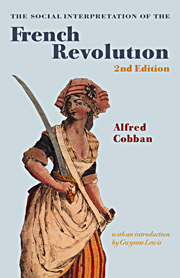Book contents
- Frontmatter
- Contents
- PREFACE
- KEY TO REFERENCES
- INTRODUCTION TO THE SECOND EDITION BY GWYNNE LEWIS
- I THE PRESENT STATE OF HISTORY
- II HISTORY AND SOCIOLOGY
- III THE PROBLEM OF SOCIAL HISTORY
- IV THE MEANING OF FEUDALISM
- V THE ATTACK ON SEIGNIORIAL RIGHTS
- VI WHO WERE THE REVOLUTIONARY BOURGEOIS?
- VII ECONOMIC CONSEQUENCES OF THE REVOLUTION
- VIII A BOURGEOISIE OF LANDOWNERS
- IX COUNTRY AGAINST TOWN
- X SOCIAL CLEAVAGES AMONG THE PEASANTRY
- XI THE SANS-CULOTTES
- XII A REVOLUTION OF THE PROPERTIED CLASSES
- XIII POOR AGAINST RICH
- XIV CONCLUSION
- INDEX
VI - WHO WERE THE REVOLUTIONARY BOURGEOIS?
Published online by Cambridge University Press: 05 June 2012
- Frontmatter
- Contents
- PREFACE
- KEY TO REFERENCES
- INTRODUCTION TO THE SECOND EDITION BY GWYNNE LEWIS
- I THE PRESENT STATE OF HISTORY
- II HISTORY AND SOCIOLOGY
- III THE PROBLEM OF SOCIAL HISTORY
- IV THE MEANING OF FEUDALISM
- V THE ATTACK ON SEIGNIORIAL RIGHTS
- VI WHO WERE THE REVOLUTIONARY BOURGEOIS?
- VII ECONOMIC CONSEQUENCES OF THE REVOLUTION
- VIII A BOURGEOISIE OF LANDOWNERS
- IX COUNTRY AGAINST TOWN
- X SOCIAL CLEAVAGES AMONG THE PEASANTRY
- XI THE SANS-CULOTTES
- XII A REVOLUTION OF THE PROPERTIED CLASSES
- XIII POOR AGAINST RICH
- XIV CONCLUSION
- INDEX
Summary
Historians are generally agreed that the revolution was a bourgeois revolution. ‘The class’, writes Mathiez, ‘which was going to take control of the Revolution was fully conscious of its strength and its rights.’ M. Albert Soboul echoes the same judgement: ‘The commercial and industrial bourgeoisie had a penetrating consciousness of social evolution and of the economic power which it represented. It guided, with a sure awareness of its interests, the revolution to its objective.’ All this is so clear and obvious and simple that it tempts one to ask some simple and obvious questions. In the first place, was it a class? Mathiez, I think, would have had no doubts. M. Soboul represents a later generation of historians and cannot escape the influence of a more sophisticated analysis. In contradiction to his earlier verdict, he says, ‘The bourgeoisie was diverse, it did not form a homogeneous class.’
A detailed analysis is provided by Georges Lefebvre, who divides the eighteenth-century French bourgeoisie into five groups—(a) the bourgeois proper ‘living nobly and on his property’, (b) members of the royal administration, officiers, proprietors of venal offices, some of them ennobled, (c) lawyers—notaries, procureurs, avocats, (d) members of the liberal professions—doctors, scientists, writers, artists, (e) the world of finance and commerce—shipbuilders, wholesale traders, entrepreneurs, and the upper grades of financiers starting with the Farmers General. Within each of these groups there were widely divergent levels of wealth and status.
- Type
- Chapter
- Information
- The Social Interpretation of the French Revolution , pp. 54 - 67Publisher: Cambridge University PressPrint publication year: 1999



